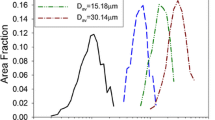Abstract
Electron backscatter diffraction and transmission electron microscopy have been used to analyze the microstructural evolution of titanium during rolling at a cryogenic temperature (T = −196°C). It has been found that intensive twinning at the cryogenic deformation temperature accelerates the kinetics of microstructure refinement. The quantitative analysis of microstructure evolution in titanium upon cryorolling has shown that structure evolution is mainly related to mechanical twinning in the initial stages. A substructure is developed and deformation-induced high-angle boundaries are formed in the range of mean and high degrees of deformation. It was established that rolling to the total degree of deformation ɛ = 93 % (e = 2.6) at T = −196°C leads to the formation of a titanium microstructure with a grain/subgrains size of approximately 80 nm. The contribution of mechanical twinning and dislocation gliding in structural transformations in titanium with increasing degree of deformation during cryorolling is discussed.
Similar content being viewed by others
References
R. Z. Valiev and I. V. Aleksandrov, Bulk Nanostructured Metallic Materials: Production, Structure and Properties (Akademkniga, Moscow, 2007) [in Russian].
R. Z. Valiev and T. G. Langdon, “Principles of equal-channel angular pressing as a processing tool for grain refinement,” Prog. Mater. Sci. 51, 881–981 (2006).
A. P. Zhilyaev and T. G. Langdon, “Using high-pressure torsion for metal processing: Fundamentals and applications,” Prog. Mater. Sci. 53, 893–979 (2008).
G. A. Salishchev, S. Yu. Mironov, and S. V. Zherebtsov, “Mechanisms of submicrocrystalline structure formation in titanium and two-phase titanium alloy during warm severe processing,” Rev. Adv. Mater. Sci., No. 11, 152–158 (2006).
Y. Beygelzimer, V. Varyukhin, S. Synkov, and D. Orlov, “Useful properties of twist extrusion,” Mater. Sci. Eng., A 503, 14–17 (2009).
H. Conrad, “Effect of interstitial solutes on the strength and ductility of titanium,” Prog. Mater. Sci. 26, 123–403 (1981).
B. A. Kolachev, Physical Metallurgy of Titanium (Metallurgiya, Moscow, 1976) [in Russian].
Y. B. Chun, S. H. Yu, S. L. Semiatin, and S. K. Hwang, “Effect of deformation twinning on microstructure and texture evolution during cold rolling of CP-titanium,” Mater. Sci. Eng., A 398, 209–219 (2005).
S. V. Zherebtsov, G. S. Dyakonov, A. A. Salem, S. P. Malysheva, G. A. Salishchev, and S. L. Semiatin, “Evolution of grain and subgrain structure during cold rolling of commercial-purity titanium,” Mater. Sci. Eng., A 528, 3474–3479 (2011).
V. A. Moskalenko, A. R. Smirnov, and A. V. Moskalenko, “Cryomechanically obtained nanocrystalline titanium: Microstructure and mechanical properties,” Low Temp. Phys. 35, 905–907 (2009).
E. V. Nesterova and V. V. Rybin, “Mechanical twinning and fragmentation of commercial titanium on the stage of developed plastic deformation,” Fiz. Met. Metalloved. 59, 395–406 (1985).
U. Zwicker, Titan und Titanlegierungen (Springer-Verlag, Berlin, 1977; Metallurgiya, Moscow,1979).
M. G. Glavicic, A. A. Salem, and S. L. Semiatin, “X-ray line-broadening analysis of deformation mechanisms during rolling of commercial-purity titanium,” Acta Mater. 52, 647–655 (2004).
A. A. Pochettino, N. Gannio, C. Vial Edwards, and R. Penelle, “Texture and pyramidal slip in Ti, Zr and their alloys,” Scr. Metall. Mater. 27, 1859–1863 (1992).
M. A. Meyers, O. Vöhringer, and V. A. Lubarda, “The onset of twinning in metals: A constitutive description,” Acta. Mater. 49, 4025–4039 (2001).
P. Hirsh, A. Howie, R. Nicholson, D. Pashley, and M. Whelan, Electron Microscopy of Thin Crystals (Butterworths, Lonson, 1977; Mir, Moscow, 1968).
D. G. Brandon, “The structure of high-angle grain boundaries,” Acta Metall. 14, 1479–1484 (1966).
S. V. Zherebtsov, G. S. Dyakonov, A. A. Salem, V. I. Sokolenko, G. A. Salishchev, and S. L. Semiatin, “Formation of nanostructures in commercial-purity titanium via cryorolling,” Acta Mater. 61, 1167–1178 (2013).
Z. S. Basinski, M. S. Szczerba, M. Niewczas, J. D. Embury, and S. J. Basinski, “The transformation of slip dislocations during twinning of copper-aluminum alloy crystals,” Rev. Metall. 94, 1037–1043 (1997).
G. Salishchev, S. Mironov, S. Zherebtsov, and A. Belyakov, “Changes in misorientations of grain boundaries in titanium during deformation,” Mater. Characterization 61, 732–739 (2010).
N. Stanford, U. Carlson, and M. R. Barnett, “Deformation twinning and the Hall-Petch relation in commercial purity Ti,” Metall. Mater. Trans. A 39, 934–944 (2008).
M. R. Barnett, Z. Keshavarz, A. G. Beer, and D. Atwell, “Influence of grain size on the compressive deformation of wrought Mg-3Al-1Zn,” Acta Mater. 52, 5093–5103 (2004).
Qian Yu, Zhi-Wei Shan, Ju Li, X. Huang, Lin Xiao, Jun Sun, and Evan Ma, “Strong crystal size effect on deformation twinning,” Nature 463, 335–338 (2010).
D. A. Molodov, A. V. Ivanov, and G. Gottstein, “Low angle tilt boundary migration coupled to shear deformation,” Acta Mater. 55, 1843–1848 (2007).
M. Winning and A. D. Rollett, “Transition between low and high angle grain boundaries,” Acta Mater. 53, 2901–2907 (2005).
J. W. Cahn and Y. Mishin, “Recrystallization initiated by low-temperature grain boundary motion coupled to stress,” Int. J. Mater. Res. 100, 510–515 (2009).
M. A. Shtremel’, Strength of Alloys. Ch. II. Deformation (MISIS, Moscow, 1997) [in Russian].
F. Humphreys and M. Hatherly, Recrystallization and related annealing phenomena, 2nd ed. (Elsevier, Oxford, 2004).
Author information
Authors and Affiliations
Corresponding author
Additional information
Original Russian Text © G.S. D’yakonov, S.V. Zherebtsov, M.V. Klimova, G.A. Salishchev, 2015, published in Fizika Metallov i Metallovedenie, 2015, Vol. 116, No. 2, pp. 191–198.
Rights and permissions
About this article
Cite this article
D’yakonov, G.S., Zherebtsov, S.V., Klimova, M.V. et al. Microstructure evolution of commercial-purity titanium during cryorolling. Phys. Metals Metallogr. 116, 182–188 (2015). https://doi.org/10.1134/S0031918X14090038
Received:
Accepted:
Published:
Issue Date:
DOI: https://doi.org/10.1134/S0031918X14090038




